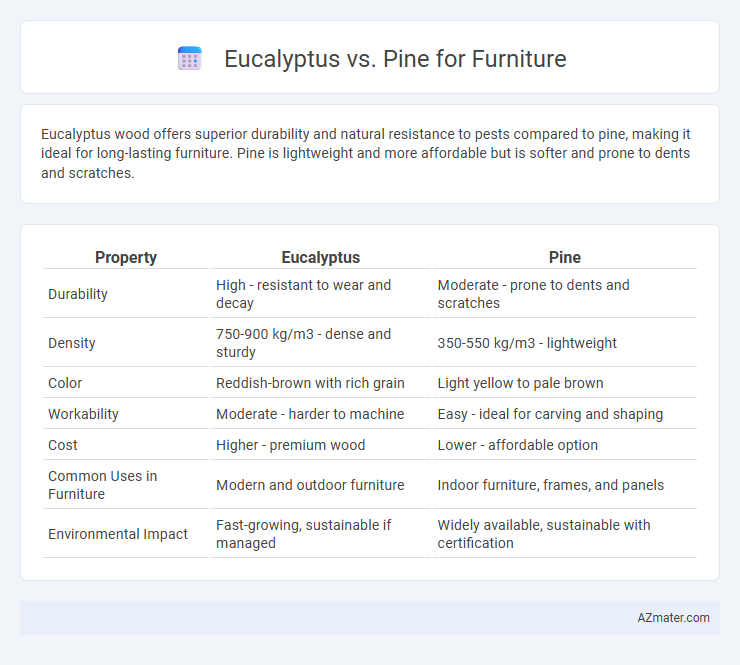Eucalyptus wood offers superior durability and natural resistance to pests compared to pine, making it ideal for long-lasting furniture. Pine is lightweight and more affordable but is softer and prone to dents and scratches.
Table of Comparison
| Property | Eucalyptus | Pine |
|---|---|---|
| Durability | High - resistant to wear and decay | Moderate - prone to dents and scratches |
| Density | 750-900 kg/m3 - dense and sturdy | 350-550 kg/m3 - lightweight |
| Color | Reddish-brown with rich grain | Light yellow to pale brown |
| Workability | Moderate - harder to machine | Easy - ideal for carving and shaping |
| Cost | Higher - premium wood | Lower - affordable option |
| Common Uses in Furniture | Modern and outdoor furniture | Indoor furniture, frames, and panels |
| Environmental Impact | Fast-growing, sustainable if managed | Widely available, sustainable with certification |
Overview: Eucalyptus vs Pine for Furniture
Eucalyptus wood is dense, durable, and naturally resistant to pests and moisture, making it ideal for long-lasting furniture with a rich, reddish-brown hue. Pine is softer, lightweight, and more affordable, featuring a pale yellow color with prominent knots that lends a rustic charm to furniture. Both woods are popular choices, with eucalyptus favored for strength and longevity, while pine offers ease of workability and a more budget-friendly option.
Wood Characteristics: Eucalyptus and Pine
Eucalyptus wood is dense, durable, and resistant to moisture and insects, making it ideal for long-lasting, outdoor furniture with a smooth finish and rich grain patterns. Pine wood is softer, lighter, and less dense, offering ease of carving and a warm, rustic appearance but requiring more maintenance due to susceptibility to dents and moisture damage. The hardness and natural oils in eucalyptus make it more resilient for heavy use, while pine's affordability and workability appeal to budget-conscious projects and casual furniture styles.
Durability and Strength Comparison
Eucalyptus wood offers exceptional durability due to its dense grain structure, making it highly resistant to moisture, decay, and pests compared to pine. Pine, being a softer wood, is prone to dents and scratches but provides decent strength for lightweight furniture applications. For long-lasting furniture with high resistance to wear and environmental stress, eucalyptus outperforms pine in both durability and strength metrics.
Aesthetic Appeal and Grain Patterns
Eucalyptus wood features a fine, straight grain with subtle variations that create a smooth and elegant surface, ideal for modern and minimalist furniture designs. Pine showcases a more pronounced grain pattern with distinctive knots and swirls, offering a rustic and natural aesthetic perfect for farmhouse or country-style furniture. Both woods provide unique visual characteristics, with eucalyptus leaning towards sleek sophistication and pine embracing warmth and texture.
Workability and Ease of Crafting
Eucalyptus wood offers excellent workability due to its medium hardness and fine grain, making it responsive to cutting, sanding, and finishing for furniture crafting. Pine, being a softwood, is highly favored for ease of crafting, allowing for quick shaping and nailing but may be prone to dents and scratches. Both woods require different techniques; eucalyptus demands sharper tools for smooth finishes, whereas pine's softness benefits beginners seeking versatility in furniture making.
Environmental Impact and Sustainability
Eucalyptus wood, known for its rapid growth and high carbon sequestration, offers a more sustainable option compared to Pine, which grows slower and often requires more intensive forestry management. Eucalyptus plantations promote reduced deforestation due to their quick maturity, while Pine forests may contribute to soil degradation and biodiversity loss when harvested unsustainably. Choosing Eucalyptus furniture supports lower environmental footprint through efficient resource use and enhanced ecosystem restoration potential.
Cost and Availability
Eucalyptus wood is generally more affordable and widely available in regions like Australia and parts of Southeast Asia, making it a cost-effective choice for furniture manufacturing. Pine offers a lower price point in North America and Europe due to its faster growth rate and abundant supply, resulting in steady availability and budget-friendly options for furniture production. Both woods provide economical solutions, but local market conditions heavily influence their cost and accessibility for furniture makers.
Suitability for Indoor and Outdoor Furniture
Eucalyptus wood offers excellent durability and natural resistance to moisture and insects, making it highly suitable for both indoor and outdoor furniture, especially in humid environments. Pine, while popular for indoor furniture due to its lightweight and ease of staining, lacks the natural weather resistance of eucalyptus and requires treatment or sealing to withstand outdoor conditions. Eucalyptus's dense grain and hardness provide long-lasting strength outdoors, whereas pine's softer texture is more prone to dents and decay when exposed to the elements.
Maintenance and Longevity
Eucalyptus furniture requires regular sealing and oiling to maintain its durability and resist moisture damage, while pine demands more frequent refinishing due to its softer wood prone to dents and scratches. The dense, oily composition of eucalyptus naturally enhances its resistance to decay and pests, contributing to prolonged longevity compared to pine's susceptibility to wear over time. Choosing eucalyptus can result in lower long-term maintenance costs and increased lifespan for furniture exposed to varying environmental conditions.
Which Is Better: Eucalyptus or Pine for Furniture?
Eucalyptus wood offers superior durability and resistance to moisture compared to pine, making it an excellent choice for outdoor and high-use furniture. Pine is lighter, easier to work with, and more cost-effective but tends to be less durable and more prone to dents and scratches. For long-lasting furniture with a harder surface and better weather resistance, eucalyptus is generally the better option.

Infographic: Eucalyptus vs Pine for Furniture
 azmater.com
azmater.com